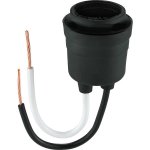In case a Scott-T transformer with a a neutral tap on the teaser winding is not available (or even a Scott-T without such a tap), another alternative could be the following:
1. First create voltages equivalent to a 240/120V 4-wire high leg delta supply.
If the 5-wire two-phase conductors are a, a', b, b' and n, then a-n-a' can be used directly for the A-N-C high leg delta voltages. Then the high leg B phase can be created by a single phase 240-208V transformer with b-b' driving the primary. One end of the 208V secondary winding would be connected to the neutral, and the other would provide the high leg B phase.
2. Then use a standard 240-208Y/120V delta-wye to provide 208/120V from the A,B,C voltages above.
Not quite as ideal as a Scott-T with the proper neutral tap, but it would likely be simpler, cheaper, and little more efficient than a Scott-T driving the delta-wye. It would also allow the output voltages to be easily balanced using the taps on the delta-wye.



